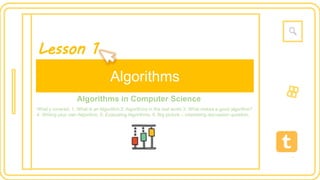
1 - Amazing Algorithms (Intro)
- 1. 12:38 Algorithms Algorithms in Computer Science What’s covered: 1. What is an Algorithm 2. Algorithms in the real world 3. What makes a good algorithm? 4. Writing your own Algorithm. 5. Evaluating Algorithms. 6. Big picture – interesting discussion question. Lesson 1
- 2. 12:38 Definition of an algorithm. For your notebooks: In essence, algorithms are simply a series of instructions that are followed, step by step, to do something useful or solve a problem. Starter question: I have a series of facedown cards. One of them is the number “7”. The cards are organised in ascending order (smallest to biggest). You can flip one card at a time. What is the quickest way to find number 7? index numbers
- 3. 12:38 You have just developed an algorithm! 1. Flip over the first card 2. If it is not 7, then flip over the second card 3. Keep doing this until the number 7 is found! The above algorithm is essentially a LINEAR SEARCH. It will work but if no. 7 is at the end, it will take a long time. Imagine if you had a million cards! Can you think of a better way? (answer revealed in this series!) 7 7 index numbers
- 4. 12:38 Why are algorithms important? • They organize thought and action (computational thinking) • They can be made very precise for implementation on computers, smart phones, and other devices • in a variety of programming languages (e.g. Python, R, Java) • as computer programs, software packages, mobile apps • A computer program is an implemented algorithm
- 5. 12:38 Are these algorithms? • Recipe • Addition and subtraction sums
- 6. 12:38 Every time you use Google or Facebook • Every time you hit the search button on Google, the search engine sifts through thousands, if not millions of webpages, to spit out the content you are seeking in a fraction of a second. • What makes this possible is the underlying algorithm—a simple set of mathematical rules embedded in the software. Facebook and Google search are also based on algorithms, though they are more complex than the regular algorithms," he said.
- 7. 12:38 Task: You have been given the task to program a kid-friendly robot. The robot must move around the room and must ask young children if they have washed their hands and encourage them to do so if they have not. It must continue to do this until every pupil in the class has washed their hands. Write an algorithm to achieve this. The robot will follow your instructions. 1: Take two steps forward. 2: If you collide with a pupil, ask the pupil for their name …
- 8. sda 12:38 What makes a good algorithm? Suggested activity: A few pupils can read out their algorithm. Evaluate: 1. What are some good points about their algorithm? 2. How could they improve it?
- 9. sda 12:38 What makes a good algorithm? Correctness: the algorithm performs the task without error Efficiency: the algorithm uses as little time and/or as little space as necessary, but there is almost always a trade-off between time and space Comprehensibility: the algorithm can be understood (which helps with human efficiency) C E C Can you improve yours?
- 10. sda 12:38 Interesting reading Do humans have algorithms? Underlying that idea is another: that organisms — including human beings — are essentially algorithmic. That even the human mind is itself only a super-complex algorithm, and in order to model it perfectly all we need to do is build our own algorithm of sufficient sophistication. Is there more to a human or are we essentially very complex input- processing-output machines? What do you think?
- 11. sda 12:38 “Big picture” discussion Sometimes we hear it said that certain behaviours are “hard wired” like permanent algorithms into us. Some people have personalities that are “angry” and others are always “fearful”. Are there algorithms at play in our own humanity? Can we alter these apparent algorithms? How?
- 12. sda 12:38 Next Lesson • Types of Algorithms • Pseudocode and Flowcharts
Editor's Notes
- Encourage students to think about different algorithms that would be most efficient at retrieving the number 7, if number 7 was the third card or the last card!
- The answer is yes! Image source: preppykitchen.com
- The answer is yes! Image source: preppykitchen.com
- https://medium.com/dataseries/you-are-not-an-algorithm-e401c722e9c7